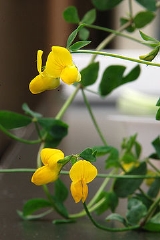
Lotus japonicus
Encyclopedia
Lotus japonicus is a wild legume that belongs to family Fabaceae
. Members of this family are very diverse, constituting about 20,000 species. They are of significant agricultural and biological importance as many of the legume species are rich sources of protein and oil and can also fix atmospheric nitrogen.
L. japonicus has become a model plant for genome studies in legumes, particularly in reference to rhizobial and arbuscular mycorrhizal symbiosis
. Small genome size of about 470 Mb, diploid genome with 6 haploid chromosomes and a short life cycle of about 2 to 3 months makes it a convenient plant to study.
L. japonicus does have several similar characteristics to the legume Medicago truncatula
, but they are phylogenetically different and exhibit two different development systems for nodulation.
Fabaceae
The Fabaceae or Leguminosae, commonly known as the legume, pea, or bean family, is a large and economically important family of flowering plants. The group is the third largest land plant family, behind only the Orchidaceae and Asteraceae, with 730 genera and over 19,400 species...
. Members of this family are very diverse, constituting about 20,000 species. They are of significant agricultural and biological importance as many of the legume species are rich sources of protein and oil and can also fix atmospheric nitrogen.
L. japonicus has become a model plant for genome studies in legumes, particularly in reference to rhizobial and arbuscular mycorrhizal symbiosis
Symbiosis
Symbiosis is close and often long-term interaction between different biological species. In 1877 Bennett used the word symbiosis to describe the mutualistic relationship in lichens...
. Small genome size of about 470 Mb, diploid genome with 6 haploid chromosomes and a short life cycle of about 2 to 3 months makes it a convenient plant to study.
L. japonicus does have several similar characteristics to the legume Medicago truncatula
Medicago truncatula
Medicago truncatula is a small legume native to the Mediterranean region that is used in genomic research. It is a low-growing, clover-like plant 10–60 cm tall with trifoliate leaves. Each leaflet is rounded, 1–2 cm long, often with a dark spot in the center...
, but they are phylogenetically different and exhibit two different development systems for nodulation.

